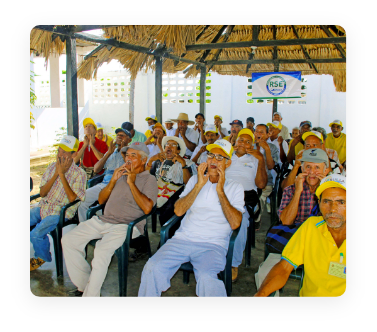Glossary
A
A unit of the National Dispatch Center under Acts 142 and 143 of 1994, in charge of the registration of commercial borders, long-term energy agreements; the settlement, billing, collection and payment of the value of acts, contracts, transactions and in general any obligation resulting from the trade of electricity in the power exchange, for generators and sellers; of the Firm Energy Obligation Auctions; of the maintenance of the required information systems and computer programs; and of the fulfillment of the other tasks that are necessary for the adequate operation of the Commercial Exchanges System (SIC). (Source: Res. CREG-071-2006; Art. 2)
American Society of Mechanical Engineers.
American Society for Testing and Materials
For the purposes of the application of CREG Resolution 071 of 2006, Annex 12, the definition of AUCTION AUDITOR is as follows: The Auction Auditor for agents with GPPS shall be an individual or business entity through its representatives in the GPPS Auction, with recognized experience in auditing processes, who shall perform its duties during the GPPS Seal-Bid Auction according to the parameters set forth in Annex 12 to CREG Resolution 071 of 2006. (Source: Res. CREG-071-2006; Annex, Item 12.2)
An individual or business entity that produces electricity exclusively to meet its own needs. Therefore, it does not use the public grid for purposes other than obtaining support from the National Interconnected System (SIN) and may or may not be the owner of the generation system. (Source: Res. CREG-119-1998; Art. 1)
For the purposes of CREG Resolution 082 of 2002, Self-Producers are Self-Generators and Co-Generators defined according to CREG Resolutions 084 of 1996, 085 of 1996, and 107 of 1998, as amended, complemented, or replaced. (Source: Res. CREG-082-2002; Art. 1)
B
Information system managed by the Commercial Exchanges System Administrator, subject to the rules of the Wholesale Market, where generators and traders exchange energy offers and demands, on an hourly basis, so that the Commercial Exchanges System Administrator executes the resulting contracts in the power exchange, settling, collecting, and distributing the corresponding monetary values to the parties and transporters. (Source: Res. CREG-107- 1998; Art. 1)
C
For the purposes of Resolution CREG 024 of 2005, it is defined as the set of qualifiers of phenomena inherent to the voltage waveform that allow judging the value of the deviations of the instantaneous voltage with respect to its standard form and frequency, as well as the effect that such deviations may have on electrical or other equipment.
Tariff control methodology consisting of the Distributor setting maximum charges differentiated by consumption ranges. Said charges and consumption ranges must comply with the condition that their associated revenues do not exceed the revenues associated with the Average Distribution Charge approved by the Commission. (Source. R. CREG-011-2003; Art. 2)
Quantity of gas measured at an Inlet Point or at an Outlet Point of a Transportation System, expressed in Mbtu (Million British Thermal Units) or its equivalent in the International System of Units. (Source. R. CREG-071-1999; Chapter I. Item 1.1)
Amount of Energy that the Main Control Center accepts for transportation during the Gas Day by a Transportation System. (Source. R. CREG-071-1999; Chap. I. Item 1.1)
Amount of Energy that the Shipper confirms for transportation during the Gas Day through a Transportation System, with the respective Main Control Center (CPC). (Source. R. CREG-071-1999; Chap. I. Item 1.1)
Amount of Energy delivered by the Shipper at the Inlet Point of a Transportation System during the Gas Day. (Source. R. CREG-071-1999; Chap. I. Item 1.1)
Firm Energy additional to the one previously allocated, per GPPS plant or unit, that the Participant is willing to commit in Firm Energy Obligations (FEO) from a GPPS Year. This quantity is bid for each GPPS Year in which the Participant expects to have FEO allocation increments. The aggregate Quantity of Firm Energy For GPPS Balance offered for a plant cannot be greater than the Firm Energy for the Reliability Charge (ENFICC) of the plant or unit minus the previous FEO allocations to the GPPS. Otherwise, this offer will be understood as not submitted. (Source: R. CREG – 056- 2008; Art 1)
Amount of Energy that the Shipper plans to deliver at the Inlet Point and take at the Outlet Point of a Transportation System during the Gas Day and that is included in the corresponding Nomination. (Source. R. CREG-071-1999; Chap. I. Item 1.1)
Amount of Energy that the Shipper takes at the Outlet Point of a Transportation System during the Gas Day. (Source. R. CREG-071-1999; Chap. I. Item 1.1)
These are the remaining quantities of natural gas from the fields with maximum regulated prices, which result once the allocation procedure established in Items 1 to 4 of Article 8 of Decree 2687 of 2008 is applied, i.e., those mentioned in Item 5 of said regulation. (Source. R. CREG-095-2008; Art. 1)
Natural Gas transportation capacity that the Shipper contracts with the Transporter for the Transportation Service, expressed in thousand standard cubic feet per day (MSCFD) or in its equivalent units in the International System of Units. (Source: R. CREG-071 1999; Chap. I. Num 1.1).
Maximum limit of electric power flow of each International Connection, considering the quality, safety, and stability conditions of the electric power systems, as well as the technical characteristics of the interconnection lines and equipment. This limit is calculated jointly by the operators of the systems of the Andean Community member countries or the countries with which there is an integration of electricity markets under the terms of CREG Resolution 004 of 2003 and will be part of the annex of technical parameters defined in CREG Resolution 025 of 1995. (Source: R. CREG-001-2006; Art. 1)
Maximum capacity corresponding to the sum of the export capacities of the international connections of the National Interconnected System (SIN) operating simultaneously, used for Short-Term International Electricity Transactions (TIE). (Source: R. CREG-004- 2003; Art. 3)
The part of the Theoretical Compensating Capacity that was available to meet the demand, determined with the methodology described in Annex No. 2 to CREG Resolution 116-1996. (Source: R. CREG-116-1996; Art. 1)
The maximum average unit charge in pesos per cubic meter ($/m3) allowed to be charged to the distributor for use of the grid, in accordance with the provisions of this resolution. This charge does not include the connection. (Source. R. CREG-057-1996; Art. 1)
Amount paid by the user to the electricity retailer, associated with the permanent availability of the service for the user, regardless of the level of consumption. (Source: R. CREG-112-1996; Art. 1)
The maximum distribution unit charge in pesos per kWh ($/kWh), approved by the Commission, applicable to the Electric Power Distribution Systems in Non-Interconnected Areas. (Source: R. CREG-091-2007; Art. 2)
Charge per unit of energy, expressed in $/kWh, constant during a month, which remunerates the use of the Regional Transmission Systems and the Local Distribution Systems. (Source: R. CREG-082-2002; Art. 1)
Equivalent charge for the rendering of transportation services to a group of Shippers, resulting from dividing the income obtained by a Transporter as of year-end by the volume transported (mscf) to the group of Shippers in the same period. For this calculation, the Shippers shall be grouped in the Load Factor ranges established in section 5.5.1 <4.2.3.4> of this Resolution and shall not include income from compensations, penalties, connections, and default interest. (Source. R. CREG-001-2000; Art. 2)
A variable that in the Cost Formula is applied as a factor to the billed consumption. (Source: R. CREG-112-1996; Art. 1)
Charges expressed in $/kWh that remunerate the Use Assets of Voltage Level 4 of the Grid Operators. (Source: R. CREG – 097- 2008. Art 1)
These are the charges expressed in $/kWh for each Voltage Level that remunerate the use of the Local Distribution Systems. (Source: R. CREG – 097 -2008; Art 1)
Charges, expressed in $/kWh, accumulated for each Voltage Level, which remunerate a Grid Operator for the Use Assets of the Local Distribution Systems and Regional Transmission Systems. For Voltage Levels 1, 2 and 3, these are maximum charges. (Source: R.CREG – 097- 2008; Art 1)
These are the charges, expressed in $/kWh, that remunerate the use assets of the National Transmission System. (Source: R. CREG-008-2003; Art. 1)
Usage Charges per unit of energy, expressed in $/kWh and differentiated by Load Period. (Source: R. CREG-103-2000; Art. 1)
Document and irrevocable credit, by means of which a financial institution duly authorized by the Financial Superintendence, undertakes directly or through a correspondent bank to the payment of the obligations indicated in these Regulations, upon the presentation of the Standby Letter of Credit. The form and execution of the Standby Letter of Credit shall be governed by the applicable rules of the Code of Commerce and other applicable provisions. (Source: R. CREG-094-2007; Art. 2)
A Control Center is the National Dispatch Center (CND), a Regional Control Center (RCC), a Generation Center (GC), or a Local Distribution Center (LDC), as applicable. (Source: R. CREG-080-1999; Art. 1)
Set of elements consisting of the gas meter, the pressure regulator, and the general shut-off valve. (Source: R. CREG-108-1997; Art. 1).
Unit in charge of planning, supervision, and control of the integrated operation of generation, interconnection, and transmission resources of the National Interconnected System. (Source: R. CREG-116-2003; Art. 1)
Centers responsible for short-term electricity planning, coordination, supervision, and control of the operation of the networks, substations, and generation plants under their coverage, coordinating the operation and handling of these facilities, subject to the instructions given by the CND and aiming at a safe and reliable operation of the National Interconnected System, subject to the regulations in force and the agreements of the National Operation Council. (Source: R. CREG-026-1999; Art. 1).
Centers belonging to the different gas pipelines (Transportation Systems) that are part of the National Transportation System, responsible for carrying out the operational, commercial, and other processes defined in the Standard Natural Gas Transportation Regulations. (Source: R. CREG-071-1999; Chapter I. No. 1.1).
“Process that starts with the request for gas supply services by a Shipper to the respective Producer-Seller or Seller and ends with the Confirmation of the request. (Source. R. CREG-071-1999; Chap. I. Item 1.1).”
Process that starts with the request for transportation services by a Shipper to the respective Main Control Center, with respect to the Energy Quantity and the calorific value of the gas to be delivered at the Inlet Point or to be taken at the Outlet Point of a Transportation System on a Gas Day, and ends with the Confirmation of the request. (Source. R. CREG-071-1999; Chap. I. Item 1.1)
A set of elements used as an electrical network or grid section, including transformers, if any, that has the following characteristics:
- Does not meet the minimum technical requirements established in CREG Resolution 070 of 1998 .
- Supplies electricity exclusively to a group of Regulated Users belonging to a Substandard Neighborhood, whose connections have been made without complying with the connection terms established by Resolution CREG-070 of 1998.
- They can be classified as General Usage Networks.
(Source. R. CREG-120-2001; Art. 2)
Metrological characteristics of the group of instruments and measuring transformers that meet metrological requirements aimed at maintaining the errors and variations allowed, within the specified limits. (Source: R. CREG-070-1998; Annex)
Set of provisions issued by the Commission vested with the powers provided in items 73.22 of Act 142 of 1994, which the public utilities of the sector and other persons using the fuel gas distribution systems by pipeline networks must adhere to. The regulations issued by the Ministry of Mines and Energy (MME), particularly those referring to safety, shall be an integral part of this code. (Source. R. CREG-057-1996; Art. 1)
Set of provisions issued by the Commission vested with the powers provided in items 73.22 of Act 142 of 1994, which the public utilities of the sector and other persons using the national fuel gas transportation system by pipeline networks must adhere to. It also includes the set of principles, criteria, and procedures to carry out the coordination and operation of the national transportation system and to regulate the operation of the fuel gas wholesale market through pipeline networks. The regulations issued by the Ministry of Mines and Energy (MME), particularly those referring to safety, shall be an integral part of this code. (Source. R. CREG-057-1996; Art. 1)
Process of combined production of electrical and thermal energy, which is an integral part of a productive activity, both for own or third-party consumption and for industrial or commercial processes. (Source: R. CREG-107-1998; Art. 1)
It is the individual or business entity that produces energy using a cogeneration process and may or may not be the owner of the cogeneration system. (Source: R. CREG-119-1998; Art. 1)
Activity that consists of the commercial intermediation between the agents that provide electric power generation, transmission and distribution services and the users of such services, whether or not such activity is carried out in combination with other activities of the electricity sector, as provided by the regulation and the law. (Source: R.CREG – 161 – 2008; Art 3)
This occurs when two or more agents, with prior authorization from the CREG, sell natural gas jointly in such a way that the authorized agents form a single seller. (Source: R. CREG-093-2006; Art. 1)
Activity consisting of the purchase of electric power in the wholesale market and its sale to end users, regulated or deregulated. Whoever carries out this activity is called an electricity retailer. (Source: R. CREG-108-1997; Art. 1)
Activity by any Natural Gas Producer of selling for valuable consideration its production, totally or partially, at the Inlet Point of the National Transportation System directly to Deregulated Users, to Retailers, Distributors, or other Agents that require it. It shall be understood that there is a sale regardless of the contractual form through which the gas is sold. (Source: R. CREG-023-2000; Art. 1).
Activity that consists of the commercial intermediation between the agents that provide the generation, transmission, and distribution services of electrical energy and the end users of such services, whether or not such activity is developed in combination with other activities of the electricity sector, as provided by the regulation and the law. (Source: R. CREG-091-2007; Art. 2)
Business entity that develops the trading activity in the Archipelago of San Andres, Providencia, and Santa Catalina. (Source: R.CREG – 160- 2008; Art 2)
Individual or business entity that trades electricity, either exclusively or combined with another or other activities of the electricity sector, whichever is the main activity. (Source: R. CREG-128-1996; Art. 2 – R. CREG-042-1999; Art. 1)
The component that is part of a system and that determines the maximum capacity to operate. (Source: R. CREG-108-1997; Art. 1)
Person located outside the national territory that acquires natural gas to meet the demand. (Source: R. CREG-095-2008; Art. 1)
Situation presented by the energy market when the price exchange is higher than the Shortage Price.
They define the standard cubic foot (meter) as the volume of gas, wet and dry (meeting the specifications of the Standard Natural Gas Transportation Regulations, in terms of water vapor concentration) contained in a cubic foot (meter) at an absolute pressure of 14.65 psi (1.01 bar absolute), and at a temperature of 60º F (15.56º C). The volumes and all volumetric properties of the gas transported by the National Transportation System shall meet these conditions.
Any reference to standard conditions in documents, communications, etc., related to the natural gas transportation business shall be understood as absolute pressure of 14.65 psi and temperature of 60º F (1.01 bar absolute and 15.56º C). Any other condition must be explicitly stated. (Source. R. CREG-41-2008; Art. 1)
Entity whose main function is to decide on the technical aspects to guarantee that the integrated operation of the National Interconnected System is safe, reliable, and cost-effective, as well as to act as the executive body of the Operation Rules and Regulations, in accordance with the regulations in force. (Source: Act 143 of 1994; Art. 36)
The procedure by which the intervention of a piece of equipment, a facility or part of it is requested, studied, and authorized. (Source: R. CREG-061-2000; Art. 1)
The procedure by which the immediate maintenance of an equipment, a facility, or part of it is authorized, when its condition endangers the safety of persons, the equipment, or the facility, not being able to comply with the respective maintenance scheduling procedure. (Source: R. CREG-061-2000; Art. 1)
The procedure to authorize the out of service of an equipment, a facility or part of for maintenance. (Source: R. CREG-025-1995; Annex)
For all purposes, it shall have the meaning of Article 14.33 of Act 142 of 1994. (Source: R. CREG-057-1996; Art. 1)
Quantity of cubic meters of gas, or quantity of kilowatt-hours of active energy, received by the subscriber or user in a given period, read in the respective metering equipment, or calculated by means of the methodology established in CREG Resolution 108 of 1997. For the electricity service, consumption may also be measured in Ampere-hours, as determined by the Commission. (Source: R. CREG-108-1997; Art. 1 – R. CREG-047-2004; Art. 1)
Quantity of kilovar-hours transported through the networks that make up the Regional Transmission Systems and Local Distribution Systems and registered by means of reactive energy metering equipment located at the commercial borders of the respective users. (Source: R. CREG-047-2004; Art. 1)
Written agreement in which an agent guarantees the supply service of a maximum quantity of natural gas and/or maximum transportation capacity, without interruptions, during a determined period, except on days established for maintenance and programmed work. This type of agreement requires physical backup. (R. CREG 186-2020; Art. 1)
Bilateral, written, and fixed-term agreement in which the buyer agrees to pay a percentage (% of ToP) of the contracted gas, regardless of whether it is consumed. The seller undertakes to keep at the buyer’s disposal 100% of the contracted quantity. The price of gas established for this contractual modality shall be inversely related to the Take or Pay Percentage (% of ToP), or amount of gas committed, regardless of consumption. In this contractual modality a firm or firmness-guaranteeing supply service is offered. The buyer shall have the right to use the gas paid for and not taken, within twelve (12) months following the payment of the gas not taken, at the Inlet Point contractually agreed. For this purpose, the seller may cover the delivery obligation with its own gas or with gas from third parties, assuming in any case the cost of the additional transportation required. (Source: R. CREG-023-2000; Art. 1; amended by R. CREG-070-2006; Art. 2).
System consisting of the organizational scheme and the set of plans, methods, principles, standards, procedures, and verification and evaluation mechanisms adopted by the respective company, in order to ensure that all activities, operations and actions, as well as the management of information and resources, are carried out in accordance with the constitutional and legal regulations in force, observing the policies established by management, and following the goals or objectives set out. (Source: R. CREG-053 – 2000; Art. 1)
Maneuvers performed on units of the National Interconnected System to adjust the operative variables of the System. (Source: R. CREG-080-1999; Art. 1)
Loss of the right to the supply of the public service in the event of any of the causes contemplated in Act 142 of 1994, in Decree 1842 of 1991, and in the public service contract. (Source: R. CREG-108-1997; Art. 1)
A monomial cost resulting from calculating the sum of all economic efficiency costs incurred by the service provider to supply a unit of energy, not affected by subsidies or contributions, on which the value of the bill to the user is calculated. (Source: R. CREG-082-1997; Art. 1)
Unit value in the market of a Constructive Unit ($/Constructive Unit). (Source: R. CREG-022-2001; Art. 1)
Costs associated with generations displaced in the actual dispatch by Out-of-Merit Oder Security Generations or by Redispatches. (Source: R. CREG-063-2000; Art. 1)
Energy and Gas Regulation Commission.
A Power System is in steady state stability for an operating condition if after a small disturbance it reaches a steady state operating condition similar to the condition existing before the disturbance. (Source: R. CREG-025- 1995; Annex)
D
Sum of the values of the demands corresponding to the Short-Term International Electricity Transactions (TIE), which are the result of the Coordinated Economic Dispatch process, which includes the loss factors referring to the 220 kV level and the losses of the National Transmission System. (Source: R. CREG-001-2006; Art. 1)
The Maximum additional demand (MW) required by a Co-generator connected to the National Interconnected System to cover 100% of its power needs. (Source: R. CREG-107-1998; Art. 1)
The difference between the Quantity of Energy Delivered and the Quantity of Energy Taken by a Shipper in a Gas Day. (Source. R. CREG-071-1999; Chap. I. Item 1.1)
Planning, programming, supervision, and control process of the integrated operation of the National Interconnected System, under the responsibility of the National Dispatch Center (CND) in coordination with the Regional Dispatch Centers and the companies, carried out following the criteria and procedures established in the Operation Rules and Regulations, the Grid Code, and the National Operation Council’s (CNO) agreements. (Source: R. CREG-025-1995; Annex)
The Economic Dispatch that considers Short-Term International Electricity Transactions with other economically dispatched systems. (Source: R. CREG-004- 2003; Art. 3)
Ex post generation programming by the Commercial Exchanges System (SIC), in which the actual demand is met with the actual availability of the generation plants. This dispatch is made considering the price offers in the Power Exchange, the offers of Start-Stop Prices, the offers of the international connections and the technical characteristics of the plants or units to obtain the generation combination that results in the minimum cost to meet the total demand of the day, without considering the transmission grid. (Source: R. CREG – 160-2009; Art. 3)
The average of the Monthly Average Availabilities of the immediately preceding calendar year. (Source: R. CREG-128-96; Art. 2 – R. CREG-042-1999; Art. 1)
Fixed-Term Deposit Rate
E
F
g
It is a mixture of light hydrocarbons, mainly methane, found in the reservoirs in free form or associated to oil. Natural Gas, when required, must be conditioned or treated to meet the gas quality conditions established by the CREG. (Source. R. CREG-011-2003; Art. 2)
H
I
International Community Electrical Association
International Electrotechnical Commission
L
Entity in charge of the Liquidation and Management of Accounts for the usage charges of the networks of the National Interconnected System assigned to it and of calculating the regulated income of the transporters, in accordance with the provisions of the Regulation in force. (Source: R. CREG-092-2004; Art. 1 – R. CREG- 097-2008; Art. 1)
M
N
National Electric Manufacturers Association
o
Corresponds to the following variable costs calculated by the Commercial Exchanges System Administrator, expressed in COP/MWh:
– CEE (CERE);
– FAZNI;
– Contributions Act 99 of 1993;
– Unit Cost per AGC Service, deducting the corresponding part of the negative reconciliation, as defined in Article 3 of CREG Resolution 063 of 2000, proportional to the agent’s scheduled generation (estimated and then corrected with actual allocation). (Source: R. CREG-044-2020; Art. 9)
P
Corresponds to the hours between 00:00 and 4:00 hours and 23:00 and 24:00 hours. (Source: R. CREG-103-2000; Art. 1)
Highest bid price in the respective hour, in the Power Exchange, corresponding to the generation resources that do not present inflexibility, required to cover the total demand in the Ideal Dispatch. (Source: R. CREG-004-2003; Art. 3)
Minimum price at which the agents participating in an Auction for the Allocation of Firm Energy Obligations must submit their Firm Energy for the Reliability Charge bids for that particular round. This price is defined and announced by the Auctioneer at the beginning of each round. (Source: R. CREG-071-2006; Art. 2)
In terms of tariffs, it means the provisions of Article 87.2 of Act 142 of 1994. (Source: R. CREG-057-1996; Art. 1). The Maximum Regulated Prices indicated in Article 3 of this Resolution are established at the Inlet Points of the National Transportation System and include the development and production costs of the field; the gas collection systems, treatment, dehydration, and compression facilities; gas quality measurement equipment; and the cost of the connection between the collection systems, i.e., between a producing field and an Inlet Point of the National Transportation System. (Source. R. CREG-023-2000; Art. 1)
Programa de Introducción de Cilindros Marcados definido por cada Distribuidor Inversionista de acuerdo con su Plan de Inversiones. (Fuente: Res CREG-045/08, Art. 1).
Conjunto de inversiones que proyecta realizar la empresa a cargo de los servicios de CND, ASIC y LAC para prestar exclusivamente las actividades reguladas del CND, ASIC y LAC durante el Período Tarifario. (Fuente: R. CREG-081-2007; Capítulo I )
An individual or business entity, a consortium, or a combination of them, which submits an offer in a public bidding process for the expansion of the National Transmission System. (Source: R. CREG-022-2001; Art. 1)
R
Rules designed by the Producer-Seller that govern the Auction, and that in any case must be structured in accordance with the rules stipulated in this Resolution, Decree 2687 of 2008, as amended, complemented, or replaced, and other applicable regulations. (Source. R. CREG-095-2008; Art. 1)
Business entity with which a primary shipper or an assignee shipper signs an agreement for the purchase and sale of secondary available capacity. It must correspond to one of the market participants that may purchase transportation capacity in the secondary market, in accordance with the provisions of this resolution. (Source: R. CREG 185-2020; Art. 1)
Agent requesting the provision of transportation services. (Source. R. CREG-071-1999; Chap. I. Item 1.1)
The difference between the sum of the available capacities of the generating units and the sum of their programmed generation in the hour considered. (Source: R. CREG-025-1995; Annex)
This is the part of the operating reserve located in plants that are operating and can respond to generation changes in periods of up to 30 seconds. (Source: R. CREG-025-1995; Annex)
It is the energy generation capacity not necessary to meet the demand at the 95% reliability level, but which is available to meet the energy demand in extreme cases in accordance with the flexibility and vulnerability criteria adopted by the Mining and Energy Planning Unit in preparing the Reference Expansion Plan. (Source: R. CREG-024-1995; Art. 1)
The procedure used to bring the power system from an emergency state to a normal operating state. (Source: R. CREG-025-1995; Annex)
Limitation in the equipment of the National Interconnected System, or of the International Interconnections, such as admissible thermal limits in the operation of transmission or transformation equipment, limits in the operation of the equipment resulting from the protection scheme (local or remote), equipment capacity limits, or equipment unavailability. (Source: R. CREG-063-2000; Art. 1)
S
Gas transportation service that goes against the physical gas flow of a gas pipeline of the National Transportation System. (Source. R. CREG-001-2000; Art. 2)
Son equipos que participan en el funcionamiento de los generadores y subestaciones, actuando en la alimentación de los equipos de mando y control de los mismos. (Fuente: R. CREG-025-1995; Anexo)
Gas supply service in which an Agent guarantees by means of a written contract the supply of a maximum volume of natural gas without interruptions during a determined period of time, except for the days established for maintenance and programmed work. (Source. R. CREG-070-2006; Art. 1)
Equipment that participates in the operation of generators and substations, acting in the supply of their command and control equipment. (Source: R. CREG-025-1995; Annex)
T
An indicator of the Total Harmonic Distortion of Voltage, with respect to the standard wave, expressed in percentage. The way to calculate it is defined in IEEE Standard 519 [1992]. (Source: R. CREG-024-2005; Art. 1)
- Very Fast Duration Typical Magnitude (pu)
1.1 Sink 0.5 – 30 cycles 0.1 – 0.9
1.2 Peak 0.5 – 30 cycles 1.1 – 1.8
- Fast
2.1 Interruption 0.5 cycles – 3 s
2.2 Sink 30 cycles – 3 s 0.1 -0.9
2.3 Peaks 30 cycles -3 s 1.1 -1.4
- Slow
3.1 Interruption 3 s – 1min <0.1
3.2 Sink 3 s – 1min 0.1 – 0.9
3.3 Peak 3 s – 1min 1.1 – 1.2
(Source: R. CREG-024-2005; Art. 1)
Son aquellos proyectos contenidos en el Plan de Expansión emitido por la UPME y/o los trabajos necesarios para la entrada en operación comercial de estos Activos de Conexión al STN o de Uso del STN. (Fuente: R. CREG-061-2000; Art. 1)
Market Representative Exchange Rate
U
Set of elements that make up a typical unit of an electrical system, destined to the connection of other elements of a network, to the transportation or transformation of electric power, or to the supervision or control of the operation of assets of the Regional Transmission System or a Local Distribution System, and referred to in CHAPTER 5 of the General Annex. (Source: R. CREG – 097 – 2008; Art 1)
Mining and Energy Planning Unit. (Source: R. CREG-070-1998; Annex)
Individual or business entity whose power purchases are subject to tariffs.
V
El resultado de evaluar a precios de mercado el valor que tiene el patrimonio de una empresa o el que se le haya asignado a una actividad, medido a través del valor presente del flujo de caja libre descontado, tal y como se presenta en el anexo 1 de esta resolución. (Fuente: R. CREG-038-1996; Art. 1)
Es el cambio porcentual entre dos períodos definidos, resultante de establecer la división entre el número índice del período más reciente sobre el número índice del período desde donde se desea medir la variación. (Fuente: R. CREG-112-2001; Art. 1)
Difference between the amount of energy authorized by the transporter and the amount of energy taken by the shipper at an outlet point, measured on an hourly or daily basis. The measurement of output variations will be daily for outlet points where the contracted transportation capacity is less than five thousand standard cubic feet per day (5 MSCFD) and hourly for outlet points where the contracted transportation capacity is greater than or equal to five thousand standard cubic feet per day (5 MSCF). In the case of retailer distributors and VNG stations directly connected to the National Transportation System, this measurement will be daily regardless of the contracted transportation capacities. (Source. R. CREG-88-2015; Art. 1)
Período de tiempo fijado regulatoriamente en 20 aá±os durante el cual los activos son operados y mantenidos para prestar adecuadamente la función para la cual fueron diseñados y construidos. (Fuente: Res. CREG-122/08, Art. 1).
Period of time fixed at 20 years, considered as the USEFUL life of an asset, counted from the date of its entry into operation. (Source: R. CREG-001-2000; Art. 2).













